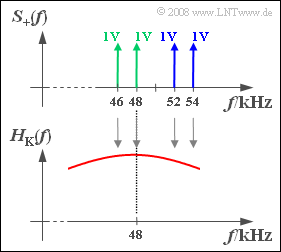Exercise 2.10: SSB-AM with Channel Distortions
Let us consider the transmission of the source signal
- $$q(t) = 2\,{\rm V} \cdot \cos(2 \pi f_2 t) + 2\,{\rm V} \cdot \cos(2 \pi f_4 t)$$
over a Gaussian bandpass channel with center frequency $f_{\rm M} = 48 \ \rm kHz$.
- This is different from the carrier frequency $f_{\rm T} = 50 \ \rm kHz$ used in modulation.
- The frequencies $f_2$ and $f_4$ stand for $f = 2 \ \rm kHz$ und $f = 4 \ \rm kHz$, resp.
We will now investigate the following modulation methods with respect to the spectrum $S_+(f)$ of the analytical signal as shown in the upper graph:
- DSB–AM $($all four spectral lines at $46 \ \rm kHz$, $48 \ \rm kHz$, $52 \ \rm kHz$ and $54 \ \rm kHz)$ ⇒ "double-sideband" ,
- USB–AM $($only blue spectral lines at $52 \ \rm kHz$ and $54 \ \rm kHz)$ ⇒ "upper-sideband",
- LSB–AM $($only green spectral lines at $46 \ \rm kHz$ and $48 \ \rm kHz)$ ⇒ "lower-sideband".
In each case, a synchronous demodulator is used to first convert the receiver-side carrier signal
- $$ z_{\rm E} (t) = \left\{ \begin{array}{c} 2 \cdot z(t) \\ 4 \cdot z(t) \\ \end{array} \right.\quad \begin{array}{*{10}c} {\rm{for}} \\ {\rm{for}} \\ \end{array}\begin{array}{*{20}c} {\rm DSB} \hspace{0.05cm}, \\ {\rm USB, LSB} \hspace{0.05cm} \\ \end{array}$$
by multiplication and then completely suppresses the components at twice the carrier frequency. With an ideal channel $H_{\rm K}(f) = 1$ , $v(t) = q(t)$ would hold in all cases.
The Gaussian channel considered here is given by the following auxiliary values:
- $$ H_{\rm K}(f = 46\ {\rm kHz}) = 0.968,\hspace{0.3cm}H_{\rm K}(f = 48\ {\rm kHz}) = 1.000,\hspace{0.3cm} H_{\rm K}(f = 52\ {\rm kHz}) = 0.882,\hspace{0.3cm}H_{\rm K}(f = 54\ {\rm kHz}) = 0.754\hspace{0.05cm}.$$
In each case, write the sink signal in the form
- $$v(t) = A_2 \cdot \cos(2 \pi f_2 \cdot (t - \tau_2)) + A_4 \cdot \cos(2 \pi f_4 \cdot (t - \tau_4))\hspace{0.05cm}.$$
All calculations are to be carried out for both a perfect phase synchronization $(Δϕ_{\rm T} = 0)$ as well as for a phase offset of $Δϕ_{\rm T} = 30^\circ$. This is present, for example, if the transmit-side carrier signal is cosine-shaped and the receiver-side carrier is:
- $$ z_{\rm E} (t) = A_{\rm E} \cdot \cos(\omega_{\rm T} \cdot t - 30^\circ) . $$
Hints:
- This exercise belongs to the chapter Single-Sideband Modulation.
- Reference will also be made to the chapter Synchronous Demodulation.
Questions
Solution
- $$\alpha_2 = {1}/{2} \cdot \left[ H_{\rm K}(f = 48\,{\rm kHz}) + H_{\rm K}(f = 52\,{\rm kHz})\right] = 0.981,$$
- $$\alpha_4 = {1}{2} \cdot \left[ H_{\rm K}(f = 46\,{\rm kHz}) + H_{\rm K}(f = 54\,{\rm kHz})\right] = 0.861\hspace{0.05cm}.$$
- Thus, we get the amplitudes $A_2\hspace{0.15cm}\underline{ = 1.882 \ \rm V}$ and $A_4\hspace{0.15cm}\underline{ = 1.722 \ \rm V}$.
(2) For DSB-AM, a phase offset between the carrier frequencies at transmitter and receiver, resp., leads to one and the same attenuation for all frequencies:
- $$A_2 = \cos (30^\circ) \cdot 1.882\,{\rm V} \hspace{0.15cm}\underline {= 1.630\,{\rm V}},$$
- $$A_4 = \cos (30^\circ) \cdot 1.722\,{\rm V} = 1.491\,{\rm V}\hspace{0.05cm}.$$
- The delay times are $τ_2\hspace{0.15cm}\underline {= 0}$ and $τ_4 = 0$.
(3) For USB–AM, the attenuation factor $α_2$ is only determined by $H_{\rm K}(f = 52\ \rm kHz)$.
- Since the principal USB amplitude loss by a factor of $2$ is compensated for by a larger carrier amplitude, the following holds:
- $$A_2 = 0.882 \cdot 2\,{\rm V}\hspace{0.15cm}\underline {= 1.764\,{\rm V}},$$
- $$A_4 = 0.754 \cdot 2\,{\rm V}\hspace{0.15cm}\underline {= 1.508\,{\rm V}} \hspace{0.05cm}.$$
(4) Analogous to the solution in subtask (3), we obtain here:
- $$ A_2 = H_{\rm K}(f = 48\,{\rm kHz}) \cdot 2\,{\rm V}\hspace{0.15cm}\underline {= 2\,{\rm V}},$$
- $$A_4 = H_{\rm K}(f = 46\,{\rm kHz}) \cdot 2\,{\rm V}\hspace{0.15cm}\underline {= 1.936\,{\rm V}} \hspace{0.05cm}.$$
(5) For LSB–AM, the received signal is:
- $$r(t) = 1\,{\rm V} \cdot \cos( \omega_{\rm 48} \cdot t) + 0.968\,{\rm V} \cdot \cos( \omega_{\rm 46} \cdot t)\hspace{0.05cm}.$$
- By multiplication with the receiver-side carrier signal $z_{\rm E}(t) = 4 \cdot \cos( \omega_{\rm 50} \cdot t - \Delta \phi_{\rm T})$, applying the trigonometric addition theorem gives:
- $$v(t) = r(t) \cdot z_{\rm E}(t) = \hspace{0.15cm}\underline { 2.000\,{\rm V}} \cdot \cos( \omega_{\rm 2} \cdot t - \Delta \phi_{\rm T})+\hspace{0.15cm}\underline { 1.936\,{\rm V}} \cdot \cos( \omega_{\rm 4} \cdot t - \Delta \phi_{\rm T}) + {\rm components \hspace{0.15cm}around\hspace{0.15cm}} 2f_{\rm T}\hspace{0.05cm}$$
- $$ \Rightarrow \hspace{0.3cm} A_2 \hspace{0.15cm}\underline {= 2\,{\rm V}},\hspace{0.5cm} A_4 \hspace{0.15cm}\underline {= 1.936\,{\rm V}}.$$
- Considering the downstream lowpass filter, this can also be written as:
- $$ v(t) = A_2 \cdot \cos( \omega_{\rm 2} \cdot (t - \tau_2))+ A_4 \cdot \cos( \omega_{\rm 4} \cdot (t - \tau_4))\hspace{0.05cm}.$$
- The amplitudes are unchanged compared to subtask (4). For the delay times when $Δϕ_{\rm T} = π/6$, we get:
- $$ \tau_2 = \frac {\Delta \phi_{\rm T}}{2 \pi \cdot f_2} = \frac {\pi /6}{2 \pi \cdot 2\,{\rm kHz}} \hspace{0.15cm}\underline {\approx 41.6\,{\rm µ s}},\hspace{0.5cm} \tau_4 = \frac {\Delta \phi_{\rm T}}{2 \pi \cdot f_4}= \frac {\tau_2}{2}\hspace{0.15cm}\underline {\approx 20.8\,{\rm µ s}} \hspace{0.05cm}.$$
(6) The first and last answers are correct:
- Also for "single-sideband AM" : Attenuation distortions on the channel lead only to attenuation distortions with respect to $v(t)$.
- Phase distortions are only present for a demodulator with a phase offset in the case of "single-sideband AM".
- For "double-sideband AM", such a phase offset would not result in any distortions, but only in frequency-independent attenuation.
- Phase distortions with respect to $v(t)$ can also arise in "DSB–AM" and "SSB–AM", if these already occur on the channel.
